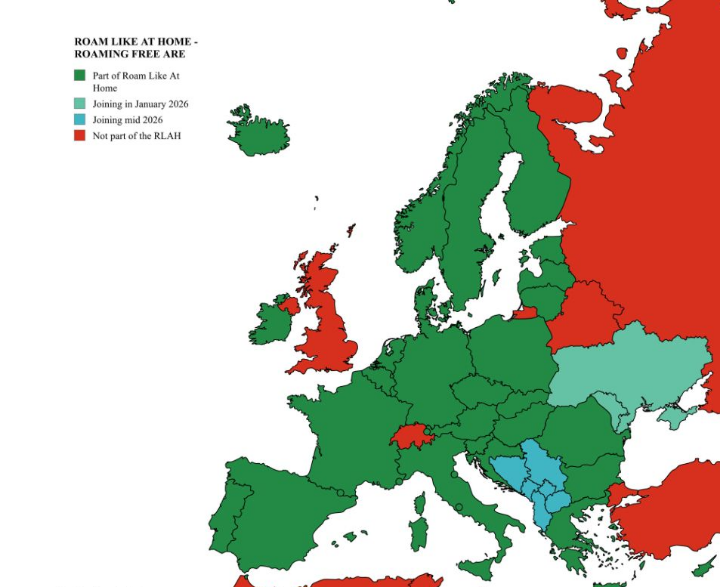Roaming-free Zone Countries in Europe Map


Marcus Rodriguez
Historical Geography Expert
Marcus Rodriguez specializes in historical cartography and geographic data analysis. With a background in both history and geography, he brings unique...
Geographic Analysis
What This Map Shows
This map illustrates the roaming-free zone countries in Europe, highlighting the nations where travelers can enjoy mobile services without incurring additional roaming charges. As of June 2017, the European Union implemented regulations that allow citizens to use their mobile devices across member states without facing extra fees. This visualization not only marks the countries included in this policy but also emphasizes the interconnectedness of the EU and its commitment to fostering seamless communication among its member states.
Deep Dive into Roaming Charges in Europe
Ever wondered why roaming charges exist in the first place? Roaming fees are typically incurred when a mobile device connects to a network outside its home country. These charges can vary widely, depending on the telecom provider and the country being visited. However, in Europe, the landscape shifted dramatically with the introduction of the EU's "Roam Like at Home" initiative. This regulation aims to eliminate excessive roaming fees, making it easier for travelers to stay connected while exploring new countries.
Interestingly, this move is grounded in the EU's broader goal of creating a single digital market. By removing barriers to mobile communications, the EU hopes to stimulate economic growth and enhance consumer rights. With this regulation, travelers can now share their experiences in real-time, use navigation apps, and stay in touch with loved ones without worrying about exorbitant fees.
As of now, the roaming-free zone includes all EU member states, as well as a few additional countries that have agreements with the EU, such as Iceland, Liechtenstein, and Norway. This means that over 500 million citizens can enjoy mobile accessibility without the fear of surprise bills when crossing borders. The impact of this policy has been substantial, with reports indicating a significant increase in mobile data usage among travelers—up to 300% in some cases!
However, it's important to note that this policy does come with limitations. For instance, fair use policies are in place to prevent abuse, such as using a SIM card purchased in one country to circumvent higher rates in another. Therefore, while the roaming-free zone significantly enhances convenience, users should still be mindful of their usage patterns to avoid potential charges.
Regional Analysis
When examining the roaming-free zone countries, we can see distinct variances in mobile service usage and consumer behavior. For example, countries like Germany and France, which have larger populations and robust economies, exhibit higher mobile data usage compared to smaller nations like Malta or Luxembourg. The sheer volume of travelers in larger countries leads to a more dynamic mobile market.
Additionally, some regions have embraced technology faster than others. Scandinavian countries, for example, often rank high in mobile internet speed and accessibility. Norway, Sweden, and Denmark have some of the highest smartphone penetration rates in Europe, leading to a culture that heavily relies on mobile connectivity. In contrast, Eastern European nations, while also part of the roaming-free zone, may have slower adoption rates, affecting how the roaming regulations impact their economies and consumer behavior.
Moreover, the tourism sector in these countries greatly benefits from the roaming-free policy. For instance, Spain, a top destination for travelers, has reported increased mobile data consumption among tourists, enhancing their overall travel experience. This increase not only benefits tourists but also local businesses that depend on mobile technology for operations and customer engagement.
Significance and Impact
The implications of the roaming-free zone extend beyond just convenience. This initiative represents a significant stride towards greater consumer rights and market integration within Europe. It reflects the EU's commitment to ensuring that citizens can communicate freely, fostering a more united community.
Current trends indicate that as mobile technology evolves, the demand for seamless connectivity will only increase. With the rise of 5G networks and more data-intensive applications, the potential for roaming policies to adapt and expand will likely be a topic of ongoing discussion.
Looking towards the future, it's crucial to consider how these policies can evolve to keep pace with technological advancements. As we become more reliant on mobile devices, ensuring that communication remains affordable and accessible will be paramount. The roaming-free zone is more than a map; it symbolizes a commitment to connectivity and collaboration across Europe, paving the way for a more integrated digital experience for all.
The next time you travel within Europe, remember the significance of the roaming-free zone and how it shapes your interactions and experiences. Whether you’re sharing beautiful landscapes on social media or navigating through a bustling city, the freedom to roam without the fear of unexpected costs truly enhances your travel adventures.
Visualization Details
- Published
- October 19, 2025
- Views
- 28
Comments
Loading comments...